Calculate Out-The-Door Price
close
× ‹
All fields are required
Submodel
Select TPMS OptionTPMSTPMS: NOTPMS: YES
WHAT IS TPMS?Enter Zip Code WHY DO WE ASK ABOUT YOUR ZIPCODE?
ZIP code is needed for local pricing.">Why?
Cross Section
Aspect Ratio
Rim Diameter
Enter Zip Code Why?
7980 S Broadway
Littleton, CO
303.515.7308
Most stores are open nights and weekends
Directions
Store Hours:
| Day(s) | Hours |
|---|---|
| MON-FRI: | 7:00am-7:00pm |
| SAT: | 7:00am-6:00pm |
| SUN: | 9:00am-5:00pm |
| CHRISTMAS EVE: | 7:00am-4:00pm |
| CHRISTMAS DAY: | Closed |
Store Details Change Store Find a Store
Schedule An AppointmentLearn more about Oil Changes
7980 S Broadway
Littleton, CO
303.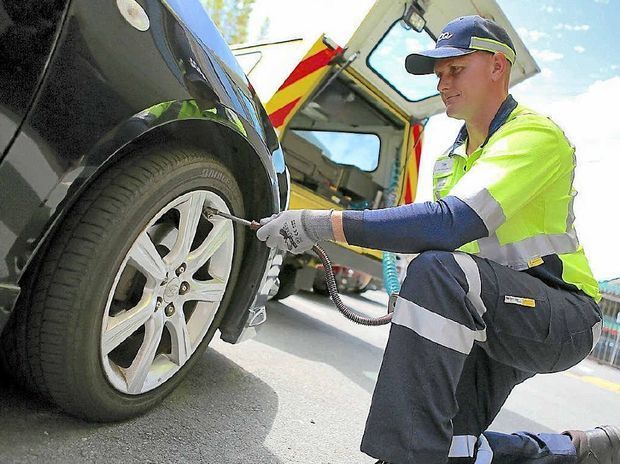 515.7308
515.7308
Most stores are open nights and weekends
Directions
Store Hours:
| Day(s) | Hours |
|---|---|
| MON-FRI: | 7:00am-7:00pm |
| SAT: | 7:00am-6:00pm |
| SUN: | 9:00am-5:00pm |
| CHRISTMAS EVE: | 7:00am-4:00pm |
| CHRISTMAS DAY: | Closed |
Store Details Change Store Find a Store
Schedule An AppointmentLearn more about Brake Service
All fields are required
Engine
Enter Zip Code Why?
All fields are required
Submodel
Enter Zip Code Why?
FIRESTONE HAS BEEN THE NATION'S LEADING TIRE PROVIDER FOR MORE THAN A CENTURY.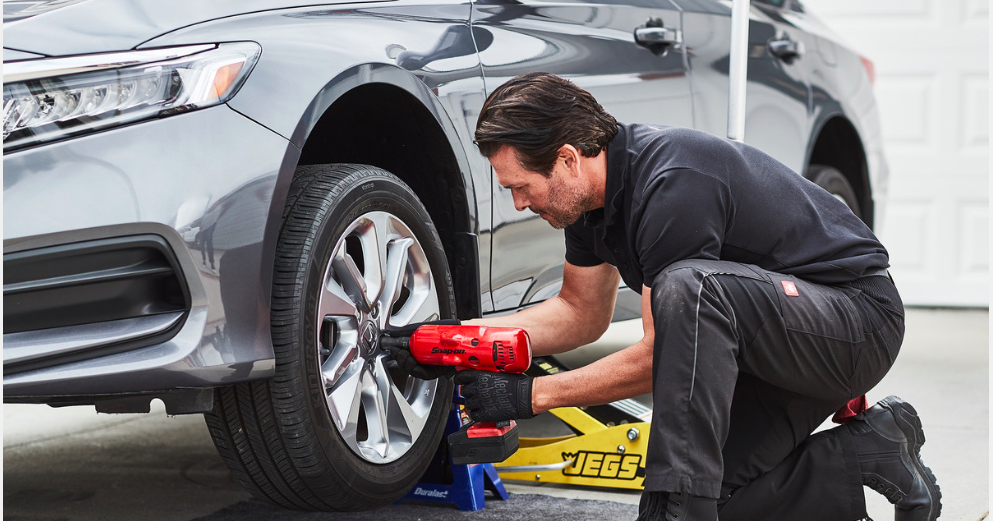
It's a tough road out there, and your tires bear the brunt of potholes, broken glass, nails, screws, and anything else that can puncture a tire. Firestone Complete Auto Care's flat tire repair services are the best in the business. We've been repairing tires since 1926, and we take pride in repairing America's tires. When tire damage strikes, come to Firestone Complete Auto Care–the tire repair shop you can trust.
If you suspect something is wrong with your vehicle's tires, don't hesitate to come into a Firestone Complete Auto Care near you. If your Tire Pressure Monitoring System (TPMS) light is on, you've hit something on the road, your tire is losing air, or maybe something just doesn't feel quite right, bring it in. One of our expert technicians will take a look and tell you if you need to repair or replace your tires.
Driving on a damaged tire can lead to additional (and more costly) rim damage and repairs, so it's best to have your tires examined at the first sign of trouble. The solution might be as simple as needing one of our patch plugs if the tire puncture is addressed early on. In other cases, a leaking valve stem or valve core may need to be replaced with a new one or the TPMS sensor needs to be reprogrammed or replaced. Visit your nearest Firestone Complete Auto Care, and we'll take care of you and your vehicle tire repairs.
The solution might be as simple as needing one of our patch plugs if the tire puncture is addressed early on. In other cases, a leaking valve stem or valve core may need to be replaced with a new one or the TPMS sensor needs to be reprogrammed or replaced. Visit your nearest Firestone Complete Auto Care, and we'll take care of you and your vehicle tire repairs.
Schedule An appointment
Tire Repair & Patching/Plug
If your tires still have life left in their tread and are not over 10 years old, Firestone Complete Auto Care maybe be able repair or patch & plug them to get you back on the road quickly. Keep in mind not all tire damage can be patched if the puncture is too big.
Tire Replacement
Over time, the tread on your tires wears down, leading to compromised traction on the road and potentially dangerous driving conditions. Tires generally need to be replaced every 25,000 to 50,000 miles, depending on vehicle manufacturer recommendations and driving habits.
Tire Rotations & Balancing
When you have your tires rotated, you help increase the life of your tires by helping reduce uneven wear. Most vehicle manufacturers recommend a tire rotation about every 5,000 miles or at the manufacturer-recommended mileage. Tire balancing helps ensure weight is evenly distributed around your tires. It's necessary about every 5,000 miles or as recommended by your manufacturer. Balancing can lead to a smoother ride, less tire wear, and reduced strain on the drivetrain. When you think tire balancing, think safe, smooth, and efficient driving.
Wheel Alignments
It's best to have your alignment checked every 6,000 miles or twice a year. Even one misaligned wheel can cause the steering wheel to be off center and can lead to premature wear and tear on your vehicle over time. Keeping everything properly aligned ensures a smoother ride for you and a longer life for your tires.
Flat Repair
A flat or leaking tire can leave you stranded on the side of the road or lead to a situation where you lose control while driving. Take care of flat or leaking tires as early as possible to extend tire lifespan and ensure your tire doesn't leave you stranded.
Schedule An Appointment
All fields are required
Engine
Zip Code Entry Why?
Flat tires rarely happen at ideal times. Let Firestone Complete Auto Care help you with these answers to frequently asked flat tire questions.
To ensure a safe drive that doesn’t damage your rims or create more expensive repairs, change your flat tire with your spare tire before coming into your local Firestone Complete Auto Care center for flat tire repair.
It’s tempting to replace just the tire that's damaged, but replacing one tire at a time can present challenges down the road since the one tire will have a different tread depth and thus different accelerating, braking, and cornering abilities than all of the others.
Few things are more inconvenient than a flat tire —except back-to-back flat tires. Learn the reasons why you keep getting flat tires and what you can do to help prevent flat tires from deflating your spirits!
If your vehicle hits a pothole in the road, you may experience steering and suspension system misalignment and/or damage, tire punctures, bent rims, and more. When your vehicle experiences a sudden jolt from a pothole run-in, timely inspection is highly recommended.
Pothole damage may not be obvious right away, but it can wreak havoc on your entire car if it’s not addressed quickly and fixed right the first time.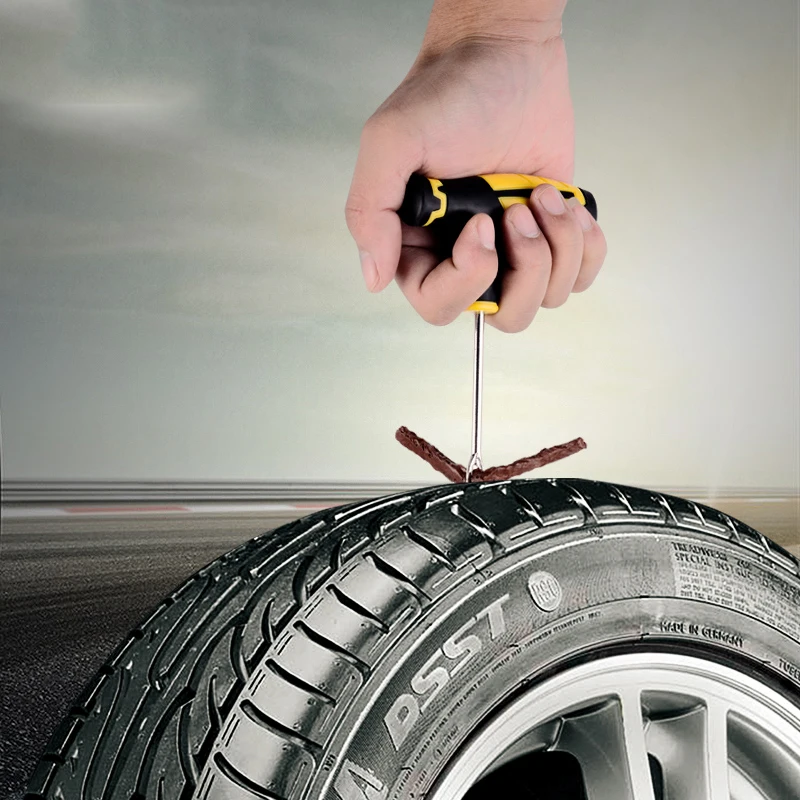 If you've had a recent run-in with a pothole, head to your local Firestone Complete Auto Care for a Complete Vehicle Inspection to check for any issues.
If you've had a recent run-in with a pothole, head to your local Firestone Complete Auto Care for a Complete Vehicle Inspection to check for any issues.
A tire plug is a quick fix for a tire that's leaking air from a nail or similar object that has punctured the tire. A tire plug fills the hole of the tire but is not reliable without a tire patch and not recommended to use alone. A patch is applied to the inside of the tire to further prevent an air leak and helps hold the plug in place. This allows a tire with ample useful life left in it to hold air reliably and keep you on the road for longer.
Run flat tires allow you to drive on a flat tire for a limited time with lesser risk than non-run flat tires. A Run Flat tire could be repaired if a nail or object is caught before tire damage occurs. However, if the tire is permanently damaged, it is required to replace a Run Flat tire with a new one.
The Tire Pressure Monitoring System light will illuminate if tire pressure is too low or part of the TPMS system has malfunctioned. Important TPMS warning light behavior:
Looking for the closest flat tire repair shop? Come to Firestone Complete Auto Care for a tire plug & patch or other tire repair service today!
Read More
Regular tire rotations can help prevent uneven tread wear and help your tires last longer. Schedule a tire rotation appointment at a Firestone Complete Auto Care near you today.
Schedule a tire rotation appointment at a Firestone Complete Auto Care near you today.
Read More
Knowing when to replace tires is as easy as measuring tire tread depth. Learn more about this important measurement and visit Firestone Complete Auto Care!
Read More
Tires
Nov 14, 2022
Need a fresh set of winter tires but don’t know what to look for? We have you covered. Read on to learn about tread patterns, tire compounds, ratings, and more!
Read More
Tires
Sep 19, 2022
What is backspacing in wheels? What about offset? Are they the same or completely separate things? Firestone has the answers you're looking for. Learn more.
Learn more.
Read More
Tires
Aug 19, 2022
What are the symptoms of unbalanced tires, and do yours need balancing? Learn everything you need to know about this often-overlooked aspect of car maintenance.
Read More
LOAD 3 MORE
SHOWING 6 OF 12
View More Articles
{{storeNumber}}
{{storeName}}
{{link-icon "Call Us" mobileCallLink null "call-cta"}} {{link-icon "Directions" directions "_blank" "directions-cta"}}
{{address}}
{{city}}, {{state}} {{zip}}
{{#if activeFlag}} {{#ifCond mystore "or" myPreferredStore}} {{#ifCond storeType 'eq' "TPL"}}
*Call store for appointment {{phone}}
{{else}} {{#if onlineAppointmentActiveFlag }}
{{#if myPreferredStore}}
{{else}}
*Call store for appointment {{phone}}
{{/if}} {{/ifCond}} {{else}} {{#ifCond storeType 'eq' "TPL"}}
*Call store for appointment {{phone}}
{{else}}
Schedule Appointment {{#if onlineAppointmentActiveFlag}} {{else}}
*Call store for appointment {{phone}}
{{/if}}
{{/ifCond}} {{/ifCond}} {{else}}
*Temporarily Closed Due To: {{temporarilyClosedReason}}
{{/if}} {{#if isMilitaryStore}}
*This location is on an active US military base. You may need military ID to access the location.
You may need military ID to access the location.
{{/if}}
{{#ifCond count 'eq' "3"}} Show More Stores {{/ifCond}}
Tesla tires are built to optimize performance, safety, reliability and durability. Since tires degrade over time from the effects of ultraviolet light, extreme temperatures, high loads and environmental conditions, always follow the recommended tire rotation schedule. For more information on ways to optimize the performance of your vehicle, see the recommended practices for vehicle maintenance.
Options When Your Tire is Damaged
Roadside Assistance is available to you, 24 hours a day, 365 days a year, for the duration of your warranty period. If your tire is damaged and your vehicle becomes inoperable, you can request roadside assistance. Learn more about our Roadside Assistance Policy.
Learn more about our Roadside Assistance Policy.
Transportation services are free of charge to your home or the nearest third-party repair facility within 80 kilometers of the vehicle’s location. Contact Roadside Assistance to learn more. In some regions, our trained roadside providers carry a limited number of loaner wheels to quickly exchange for a damaged wheel or tire. A new tire will be mounted on your original wheel, at your cost, and made available at your nearest third-party repair facility.
A puncture eventually causes the tire to lose pressure, which is why it is important to check tire pressures frequently. Replace punctured or damaged tires as soon as possible. Your tubeless tires may not leak when penetrated, provided the object remains in the tire.
If you feel a sudden vibration or ride disturbance while driving, or you suspect a tire is damaged, immediately reduce your speed. Drive slowly while avoiding heavy braking or sharp steering and, when safe to do so, stop the vehicle. Arrange to have your vehicle transported to the nearest tire shop, or consult your nearest Tesla Service Center for tire availability.
Drive slowly while avoiding heavy braking or sharp steering and, when safe to do so, stop the vehicle. Arrange to have your vehicle transported to the nearest tire shop, or consult your nearest Tesla Service Center for tire availability.
Note: If you notice your tire has been punctured and you are able to maintain control of your vehicle, try to inflate your tire and drive carefully to the closest third-party tire shop or Tesla Service Center. The tire may only lose air slowly, monitor your tire pressure closely while driving. If your tire is not able to hold air, do not keep on driving and contact Roadside Assistance.
Flat Spots on Tires
If your vehicle is stationary for a long period in high temperatures, tires can form flat spots. When the vehicle is driven, these flat spots cause a vibration which gradually disappears as the tires warm up and regain their original shape. To minimize flat spots during storage, inflate tires to the maximum pressure indicated on the tire wall. Then, before driving, release air to adjust tire pressure to the recommended levels.
Then, before driving, release air to adjust tire pressure to the recommended levels.
Maintaining Tire Pressures
Keep tires inflated to the pressures shown on the tire and loading information label, even if it differs from the pressure printed on the tire itself. The tire and loading information label is located on the center door pillar and is visible when the driver’s door is open.
Checking and Adjusting Tire Pressures
Follow these steps when tires are cold and if your vehicle has been stationary for over three hours:
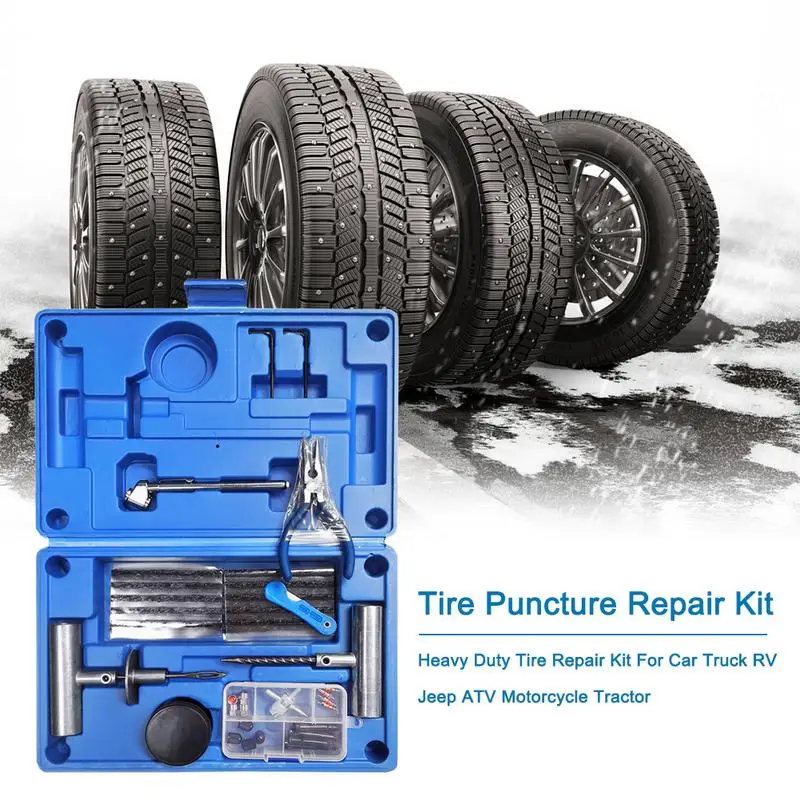
Under-inflation is the most common cause of tire failures and can cause a tire to overheat, resulting in severe tire cracking, tread separation, or blowout, which causes unexpected loss of vehicle control and increased risk of injury. Under-inflation also reduces the vehicle's range and tire tread life.
Tire Rotation, Balance and Wheel Alignment
Misaligned wheels and unbalanced tires can negatively impact vehicle handling, performance and steering. To maintain your tire and wheel, always follow the recommended Tesla tire rotation schedule.
Frequently Asked Questions
I have a flat/leaking tire, what should I do?
Check if your tire is completely flat or if it will hold air. If the tire holds air and you feel safe driving to the nearest tire shop, do so. Contact Roadside Assistance to review service options available.
What should my tire pressure be?
Depending on your vehicle configuration, your tire pressure should be between 40-45 psi. You can check for your specific vehicle by opening your driver’s door and checking the sticker along the vehicle's frame. This sticker lists the tire pressures for when the tires are cold. For most accurate results, check the tire pressure when the vehicle is at home with no driving, or is used with the shortest distance and lowest speed driving possible.
Can I take my damaged tires to a third-party tire shop?
Yes. Damaged Tesla tires can be taken to a nearby third-party tire shop for replacement.
Search
In This Article
Author: Aleksey Kokorin
Experienced drivers are not surprised by such a trifle as a puncture, but for the first time beginners usually get confused in the sequence of actions, forget about important details and do not know what to do with a punctured wheel even in a tire shop - especially if they start offering choose from several options or intimidate with expensive repairs. Let's set up an operation algorithm when a flat tire is detected and figure out what to do right away and what to choose later.
Let's set up an operation algorithm when a flat tire is detected and figure out what to do right away and what to choose later.
What to do when you find a puncture
Having found a flat tire, first of all you need to stop in a safe place, turn on the alarm, assess visibility and, if necessary, set an emergency stop sign: according to traffic rules, it is installed at least 15 meters from the car in the village and at least 30 meters outside the settlement. When choosing where to stop, consider the space to the side of the vehicle to handle a flat tire. You should not stop right on the road and in places where stopping and parking are prohibited: even if a punctured wheel belongs to the conditions of a forced stop, it is quite possible to drive several tens of meters on it to choose a safe and convenient parking place. At night or in conditions of limited visibility (for example, in fog or rain), it is imperative to wear a vest with retroreflective elements - this is required by clause 2.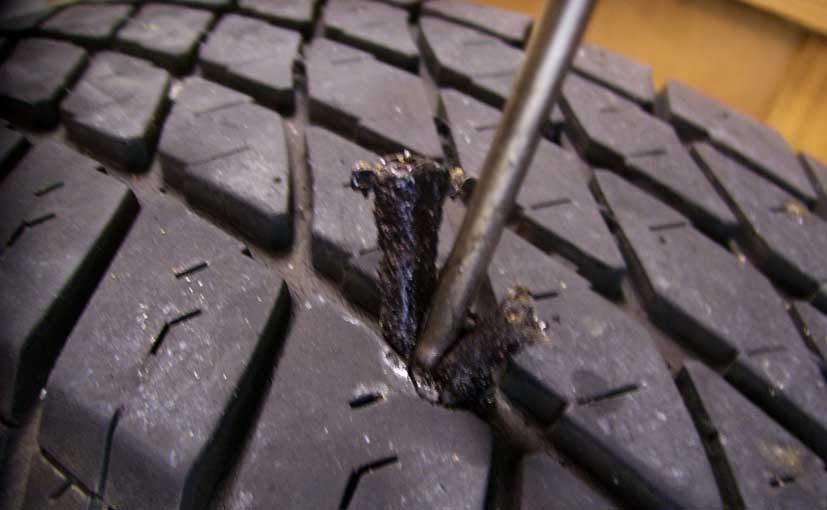 3.4 of the SDA and common sense.
3.4 of the SDA and common sense.
Now you can start working on the wheel. We will sequentially consider several options for action, and then move on to ways to repair a damaged tire.
The most obvious solution to a flat tire is to replace it. If you have a spare tire that you are sure is in good condition, the best option is to install it and visit a tire shop to repair a punctured tire - such repairs will be more reliable and of high quality than doing it yourself.
If you don't have a suitable spare tire, but you do have a pump or compressor, you can assess the damage to the tire and try to pump it up again to get to the tire shop. It is better to start searching for an air leak with a valve (aka “nipple” or “nipple”): often a faulty spool becomes the cause of a flat tire. It is easy to check it: unscrew the protective cap (if there is one), pour water on it (or slobber it, as in childhood): air bubbles will leak. In this case, you can try to replace the spool valve by unscrewing it and screwing in a new one, but if there is no new valve, as well as a store nearby, you can try just unscrewing and screwing it back in.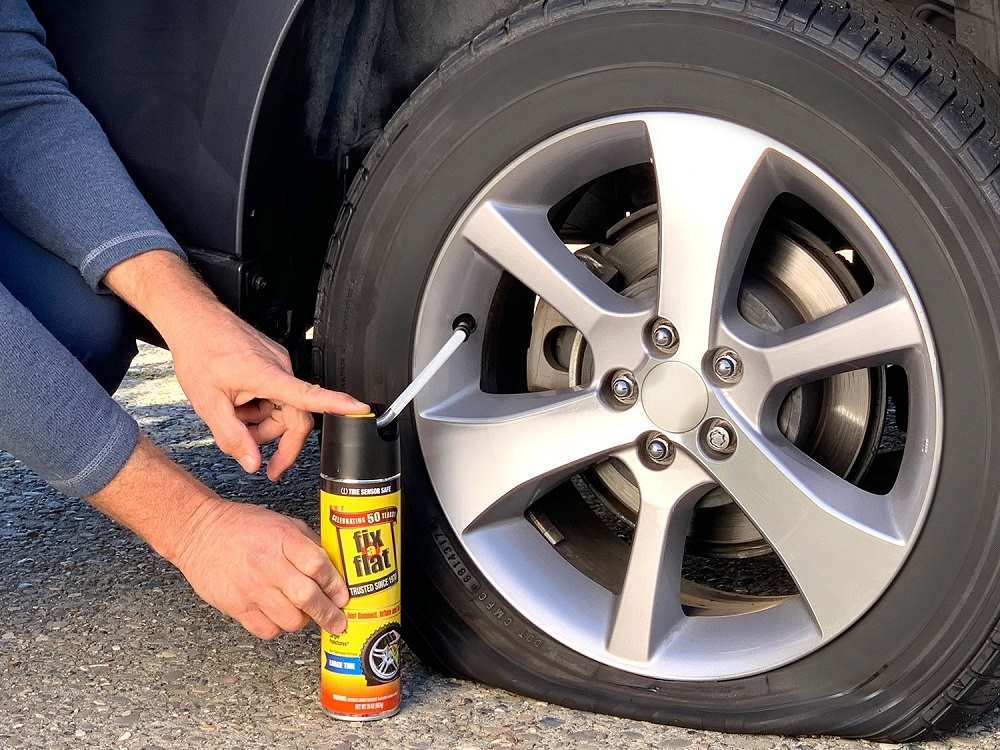 Regardless of whether it helped or not, you need to visit a tire shop to replace the entire spool or valve.
Regardless of whether it helped or not, you need to visit a tire shop to replace the entire spool or valve.
If the valve is tight and the tire is flat, it is most likely a puncture. The easiest way to find a puncture that is free of foreign objects is to spray the tire with water while looking at the surface: the damage will reveal itself as air bubbles. However, often the cause of the puncture can be found along with it: a self-tapping screw, nail or other arbitrary object sticking out of the wheel will clearly indicate the place of depressurization. In this case, you do not need to immediately remove the foreign object from the tire: it partially seals the hole, and if the pressure loss is slow, you can try to pump up the wheel and drive to the tire shop.
The same goes for wheels that are leaking from the rim or from a faulty valve. Usually, in this case, the air is bled slowly, and you can pump up the wheel and have time to get to the place of repair. By the way, rim leakage can occur due to disk deformation upon impact - for example, when hitting a pit with sharp edges. Such situations are fraught with damage to both the disk and the sidewall of the tire, in which case the disk will need to be corrected, and the tire repaired or even replaced. To avoid rim leaks, you need to inspect the rims every time you change tires. The loss of tightness occurs either due to corrosion or due to disc deformation, and not only steel, but also light alloy wheels can corrode. So if you see paint blistering or rust on the rim, the tires need to be put on rim sealant: when changing tires, this will be cheaper than the subsequent removal and re-tire to fix a leak on the rim.
Such situations are fraught with damage to both the disk and the sidewall of the tire, in which case the disk will need to be corrected, and the tire repaired or even replaced. To avoid rim leaks, you need to inspect the rims every time you change tires. The loss of tightness occurs either due to corrosion or due to disc deformation, and not only steel, but also light alloy wheels can corrode. So if you see paint blistering or rust on the rim, the tires need to be put on rim sealant: when changing tires, this will be cheaper than the subsequent removal and re-tire to fix a leak on the rim.
If you find a puncture, but there are no foreign objects in it, and you do not have a spare wheel and tire repair kits, there is another popular method of temporary "repair". You can screw a self-tapping screw into the found hole - if, of course, you have one. In extreme cases, you can look for a self-tapping screw in the cabin by unscrewing it from some interior detail. This method cannot be called reliable: it is unlikely to ensure complete tightness of the wheel, but at least it can help you get to the nearest tire shop.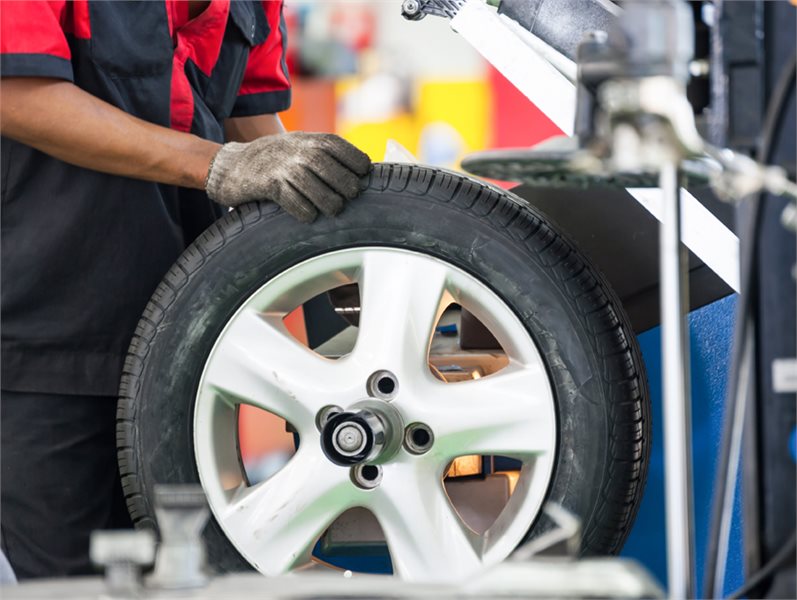
And a couple more useful remarks. If the wheel is completely flat, then it is easier to inflate it without a spool: the latter must be unscrewed, then the tire must be inflated and quickly screwed back in. The fact is that the spool itself, when inflated, resists the compressor, and in the event of a loose fit of a flat tire to the disk, the power of a simple magazine compressor may not be enough, and the absence of a spool helps to increase air flow and facilitate the operation of the compressor. If this does not help, you can jack up the car by hanging a flat tire: this will improve the fit of the tire to the disk, and the chances of inflating the tire will increase.
On-Site Repair Methods
Now let's look at options for repairing a tire yourself using special materials that you should carry with you or, if a puncture caught you in the city, buy it at the nearest auto shop.
1. The most common, cheapest and easiest way to do it yourself is to install a raw rubber band. The harnesses are sold complete with an abrasive awl to expand the hole in the tire and improve the contact of the repair harness with its edges, as well as a needle for installing the harness and an adhesive to fix it and at the same time seal the puncture. When choosing a repair kit in a store, you should pay attention to the following nuances:
The harnesses are sold complete with an abrasive awl to expand the hole in the tire and improve the contact of the repair harness with its edges, as well as a needle for installing the harness and an adhesive to fix it and at the same time seal the puncture. When choosing a repair kit in a store, you should pay attention to the following nuances:
Install the harness in the following order. First, the found hole is expanded with an abrasive awl - you need to insert and remove it several times into the puncture site. Then the tourniquet is inserted into the eye of the needle, and glue is applied to it. After that, the needle with the tourniquet must be inserted into the hole in the tire and pulled out sharply - so that the tourniquet remains in the hole, and the needle comes out without it.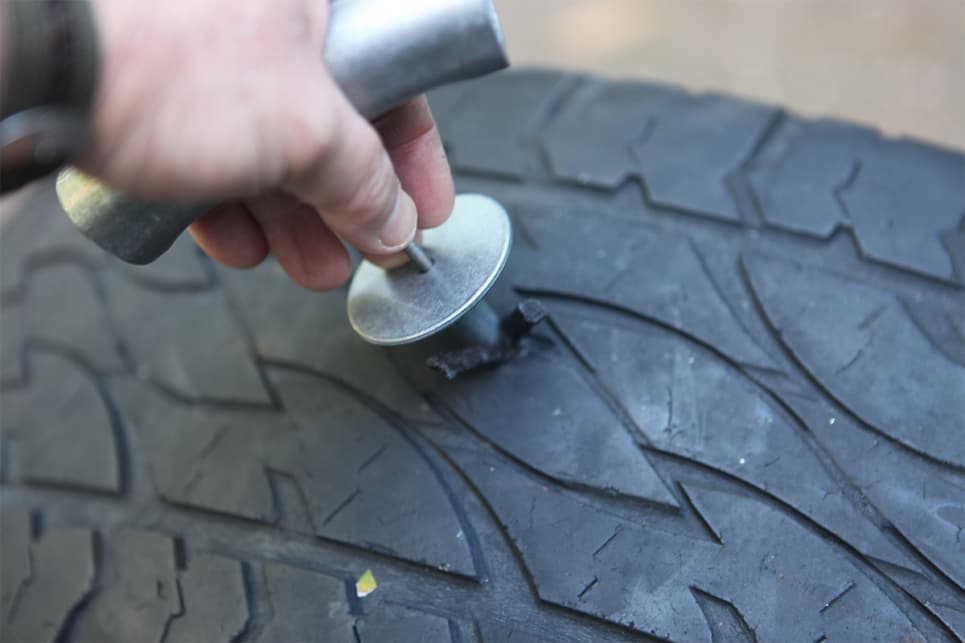 If everything worked out, it remains only to cut the end of the harness flush with the surface of the tire and pump up the wheel.
If everything worked out, it remains only to cut the end of the harness flush with the surface of the tire and pump up the wheel.
The advantages of repairing with a harness are quite decent reliability, simplicity and low cost. On a well-repaired tire, you can drive for a long time, and if the repair site starts to poison, you can either replace the harness or have the tire repaired in a quality service. Among the minuses is the possibility of damaging the cord during installation, as well as lower reliability compared to “full-fledged” repair methods in a tire shop. Strictly speaking, a tourniquet is still a temporary repair, so if it is possible to pump up a wheel and get to a tire fitting, then it is better not to enlarge the hole in the tire and get to the experts.
2. The second repair option is aerosol liquid sealants sold in cans. To repair a punctured tire with sealant, you need to remove the foreign object from the puncture site, then pour the sealant into the wheel through the valve, twist it to distribute the composition inside the tire, pump up the wheel and drive several kilometers at low speed for the final uniform distribution of the sealant.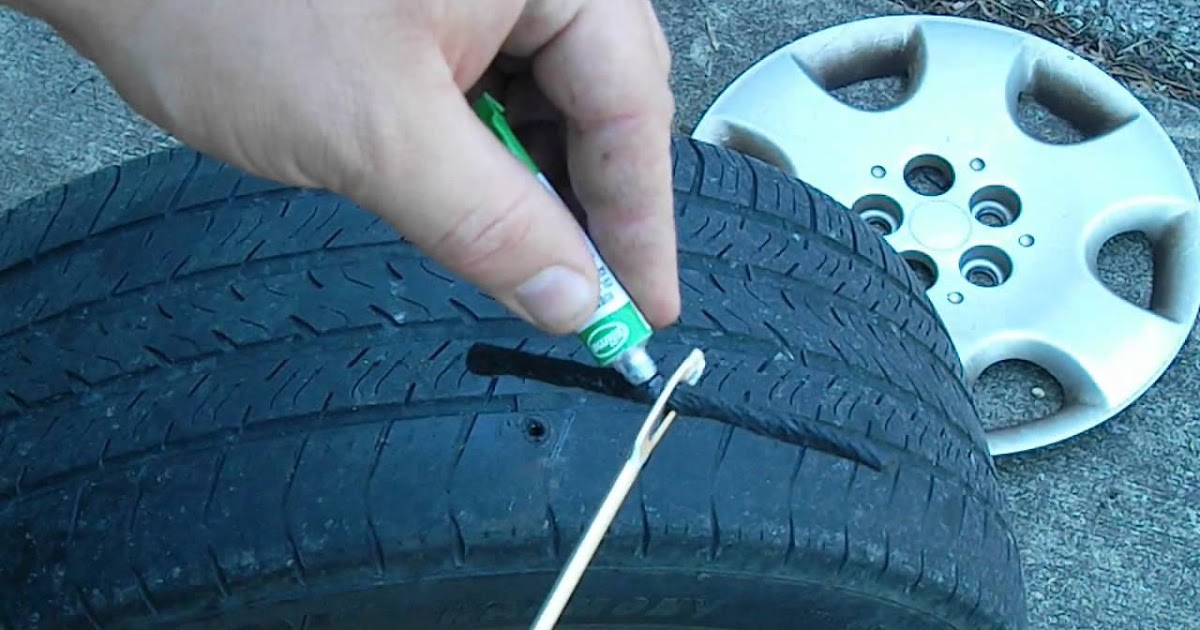
Among the advantages of this repair is the simplicity and less labor intensity compared to installing a harness. However, there are also disadvantages: the larger the hole, the higher the chance that the sealant will not be able to eliminate it, and such a repair can affect the wheel balance. Compared to a tourniquet, it can be considered even less reliable and preferable, but simpler.
Repair options at a tire shop
If you put on a spare tire and brought the wheel to a tire shop, you may also be offered several repair options. Consider the most popular with an indication of the advantages and disadvantages.
1. The first repair method is the same harness installation as described above. As we remember, the tourniquet refers to a temporary repair, so among tire specialists this method is considered bad form, but many workshops do not exclude it from the list of services. All the advantages and disadvantages are the same here: such a repair will be the fastest, simplest and cheapest, but less reliable than other methods. It is worth choosing it in cases where the price and / or speed of the procedure is more important to you than anything else. If quality is a priority, then it is better to fork out for the options listed below.
It is worth choosing it in cases where the price and / or speed of the procedure is more important to you than anything else. If quality is a priority, then it is better to fork out for the options listed below.
2. The second option for repairing a puncture is to install a patch on the inside of the tire, the so-called cold vulcanization. In this case, the tire is removed from the disk, the surface around the puncture is treated with an abrasive, and the damage is sealed with a special patch. This is a more preferred repair method than a tourniquet: it is more reliable and durable, especially in the case of side punctures, when not the thick tread part of the tire is damaged, but the thinner sidewall. Among the minuses, only a higher cost can be noted: in addition to the actual tire repair, you will have to pay for the removal and installation of the wheel (or do it yourself), tire fitting and balancing.
3. The third option is a "complex" of the first and second: installation of the so-called repair "fungus". The “hat” of the fungus is a patch, and the “leg” is threaded from the inside of the tire to the outside. After gluing the patch, the excess part of the leg is cut off, as in the case of the tourniquet. Thus, not only the inner surface of the tire is closed, but also the hole itself. The advantages and disadvantages of this repair method are generally the same as those of a patch.
The “hat” of the fungus is a patch, and the “leg” is threaded from the inside of the tire to the outside. After gluing the patch, the excess part of the leg is cut off, as in the case of the tourniquet. Thus, not only the inner surface of the tire is closed, but also the hole itself. The advantages and disadvantages of this repair method are generally the same as those of a patch.
4. An extreme, “emergency” measure when repairing a punctured wheel is to install a camera in it. Typically, this method is used for tires that are no longer worth repairing, or “for reliability” after repairing a complex puncture. It should be understood that almost all modern tires are tubeless, that is, they are not designed to install a camera, so it’s not worth driving a wheel repaired in this way for a long time. Installing a tube is a temporary solution for riding until a new tire is purchased, and sometimes such wheels are left as spares. So this repair method can be kept in mind as a backup.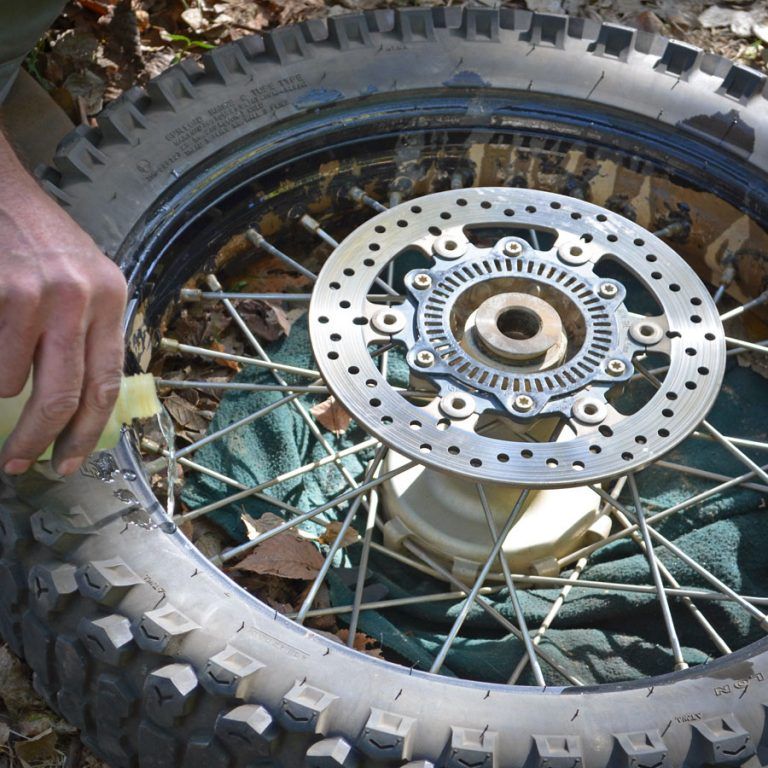
Finally
We have deliberately left out of this text such methods as combined repair of tires with a tourniquet and a patch and hot vulcanization. The first is used quite rarely and for specific damage, and it is enough just to know about its existence. Well, the second is used to repair serious side cuts, and it is not only rare, but also very expensive. The cut site in this case is prepared, filled with raw rubber and processed with a hot press for vulcanization. Equipment for this procedure is not available in every tire shop, and the cost of repair can be about half the cost of a new tire.
interesting popular questions
Articles / Exhibitions We should ride them: novelties of the international bus exhibition Busworld 2022 From November 29 to December 1, the international exhibition of buses Busworld 2022 was held in Moscow. Of course, MAN, Volvo, Scania and all the rest did not take part in this exhibition for obvious reasons... 173 0 0 02.12.2022
Of course, MAN, Volvo, Scania and all the rest did not take part in this exhibition for obvious reasons... 173 0 0 02.12.2022
Articles / Practice ATF, PSF and three different colors: what to fill in the hydraulic booster and what can be mixed Unfortunately, power steering fluid is usually remembered in two cases: when the pump is already dying and starting to howl, or if it has leaked somewhere. In a good way, of course, she also needs me ... 289 one one 02.12.2022
Articles / Practice Do No Harm: 10 Common Winter Car Mistakes In winter, the car is much more vulnerable than in the warm season.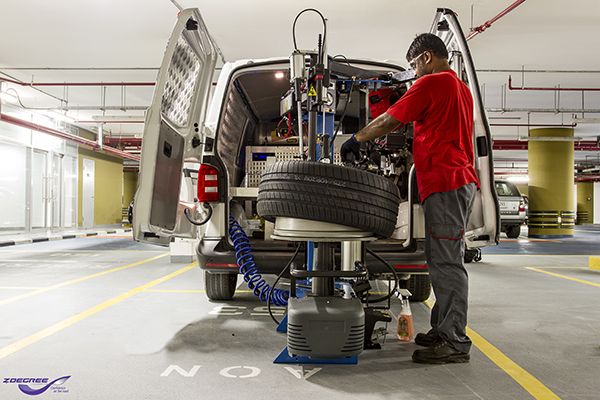 Many parts lose their flexibility, elasticity, become brittle. But a bit of attention and understanding on the part of the driver allowed ... 1844 3 2 12/01/2022
Many parts lose their flexibility, elasticity, become brittle. But a bit of attention and understanding on the part of the driver allowed ... 1844 3 2 12/01/2022
Test drives / Test drive Haval Dargo vs Mitsubishi Outlander: the dog is barking, the stranger is coming In the Haval dealership in the south of Moscow, life is in full swing: buyers look at cars, communicate with managers and sign some papers. While I was waiting for the test Dargo, the same cross... 17953 7 205 13.09.2022
Test drives / Test drive Motor from Mercedes, emblem from Renault, assembly from Dacia: test drive of the European Logan 1.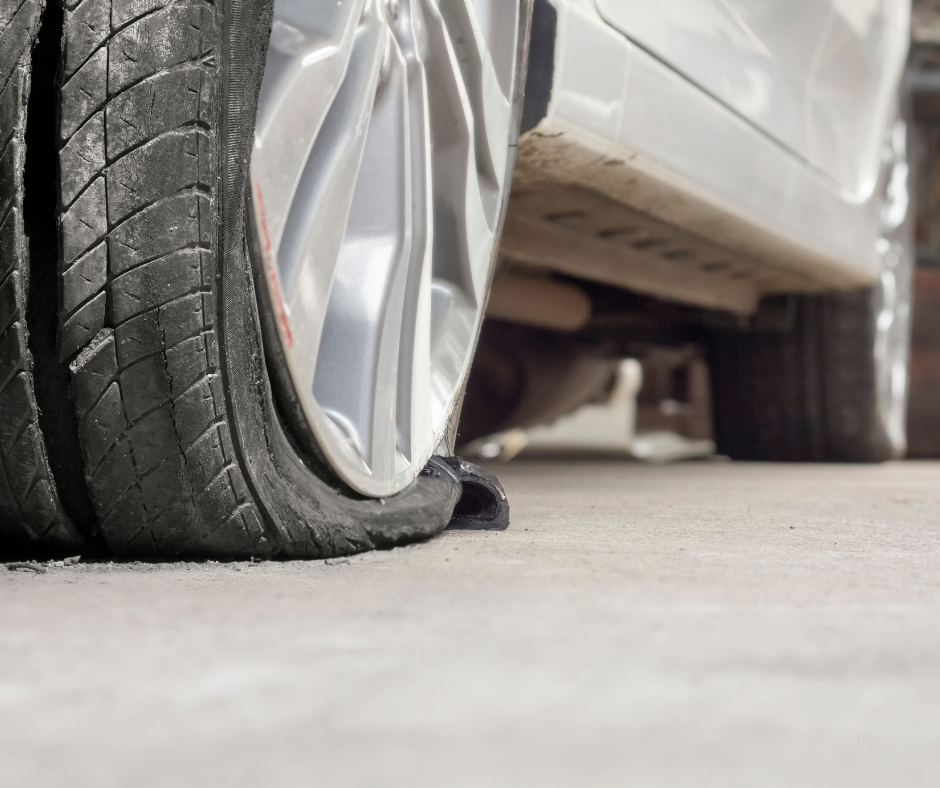 0 It would seem that what's new can be told about the second generation Renault Logan, known to every Russian taxi driver, as they say, up and down? However, this car has... 14417 ten 41 08/13/2022
0 It would seem that what's new can be told about the second generation Renault Logan, known to every Russian taxi driver, as they say, up and down? However, this car has... 14417 ten 41 08/13/2022
Test drives / Test drive Geely Coolray vs Haval Jolion: Free Cheese? If! Do you want to buy a car today with a full warranty, on credit at an adequate rate, without wild dealer markups? Now this is still a task, because a full-fledged chain of "representation - s... 11624 26 thirty 08/10/2022
Reading time of the article: 5 minutes
Bookmark this
Most cars come with tubeless wheels that keep the tire inflated during a puncture.
They guarantee safe driving even when flat, and with little damage they can hold their shape for several days. Despite their practicality, you should immediately look for the causes of wheel leaks. If you do not repair a punctured car tire in advance or do not fix warped alloy wheels, the operation of the car will lead to an emergency.
Since even tubeless tires flat for no apparent reason, you need to carefully inspect the car and the condition of the disks in order to detect a malfunction in advance. This will help to avoid a number of problems during the trip. Driving with flat tires adversely affects the performance of the machine. The vehicle has poor traction, the steering wheel pulls to the side with a bad tire, acceleration and braking are deteriorating. If the tires of the car are slowly deflated, this leads to increased fuel consumption.
To understand the problem, let's examine the reasons for which it releases air:
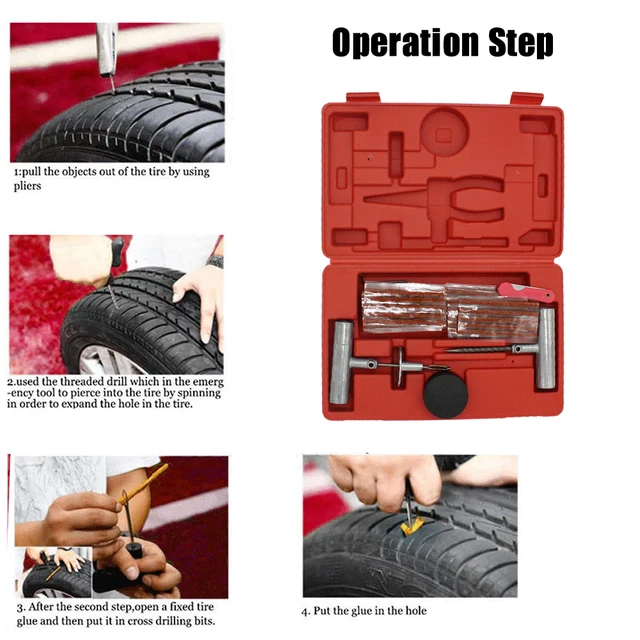 A popular cause of air bleeding. You can ruin a tire by driving a car over a self-tapping screw, a metal sheet and other objects that are found on the roads. It can bleed due to stones found on unpaved surfaces. More often, a metal object gets stuck in the wheel tread without damaging the rim and alloy wheel. Since the screw or nail remains in the tread, the air escapes slowly, which allows you to safely drive to the service. Pulling out the item yourself, if it is not possible to immediately fix the wheel, is not worth it. This will lead to depressurization.
A popular cause of air bleeding. You can ruin a tire by driving a car over a self-tapping screw, a metal sheet and other objects that are found on the roads. It can bleed due to stones found on unpaved surfaces. More often, a metal object gets stuck in the wheel tread without damaging the rim and alloy wheel. Since the screw or nail remains in the tread, the air escapes slowly, which allows you to safely drive to the service. Pulling out the item yourself, if it is not possible to immediately fix the wheel, is not worth it. This will lead to depressurization. 
It is often difficult to find the reason why the air in the wheel bleeds slowly. Even the masters can not always immediately detect a malfunction. You can find the problem yourself in the following way - pump over 1-2 atmosphere and listen to see if air comes out. If no sound is heard, then the wheel is wetted in a soapy solution and lowered into water. The area where air will begin to bubble will be the puncture site.
Even the masters can not always immediately detect a malfunction. You can find the problem yourself in the following way - pump over 1-2 atmosphere and listen to see if air comes out. If no sound is heard, then the wheel is wetted in a soapy solution and lowered into water. The area where air will begin to bubble will be the puncture site.
In cases where the wheel bleeds air on the car, but does not deflate when it is removed, it is necessary to disassemble and wipe the inside of the tire. In the presence of sharp objects, the fabric will catch on, indicating the puncture site.
Detect causes of rubber puncture near the nipple, on the rim of the alloy wheel or in the tread using indirect causes: ;

If the tire on the car began to slowly deflate as a result of a side cut, then such repairs are not easy to make even for masters. Unlike a tread puncture, the area near the rim of an alloy wheel is softer and thinner. This does not allow you to put a patch or install a harness. Even after removing the cause, the damaged wheel will slowly bleed under load. Also, repairing a side puncture is dangerous because it affects the durability of the tire. Therefore, with a strong side cut, it is better to change the wheel to a new one.
If the tread puncture is the cause of air bleeding, the tire can be easily repaired. It is important that in this case the rim of the cast disk is not damaged, and the hole size is no more than 4-5 mm. If a larger object hits, it will not be possible to repair the wheel on your own, so you need to sign up for a service station. If the tire on the car descends slowly, and the puncture diameter is several millimeters, a rubber band, glue and an awl will be needed for repair.
If the tire bead does not seal against the rim, the defect in the cast rim must be repaired first. There are many reasons why a dent appeared on the surface - due to falling into a hole at speed, upon contact with the curb. If you do not align the disk, the tire will slowly deflate, it may depressurize when driving a car. Dents are "rolled" in the service. You can fix the breakdown on your own on the road with the help of a heavy object - sometimes it is enough to hit the rim with a hammer to stop lowering. However, this is a temporary option.
If the rim is OK and the wheel continues to bleed, the problem may be in the spool. On the road, such a “puncture” can be corrected by pressing hard on the nipple. In case of deformation of the nipple, contact the specialists, as it needs to be changed.
Since the wheel itself may be the reason why the wheel began to deflate, let's look at the problem in more detail. The rim is damaged when hitting a curb, due to old age or improper storage, which affects the tightness of its fit to the tire. Deformation of a cast wheel is also possible due to poor-quality alloy.
The rim is damaged when hitting a curb, due to old age or improper storage, which affects the tightness of its fit to the tire. Deformation of a cast wheel is also possible due to poor-quality alloy.
In case of advanced corrosion or mechanical damage to the rim, the disc is repaired or replaced with a new one. It is forbidden to pour sealant inside. It won't fix the rim problem, but it will definitely ruin the tire.
Winter Disc protection
Tires Goodyear UltraGrip Arctic 2 SUV
Winter Drive Protection Sound Comfort
Rating:
4.5
Tires Goodyear UltraGrip Ice 2
Winter Drive protection
Tires Goodyear UltraGrip Performance+ SUV
Winter Drive protection
Tires Goodyear UltraGrip Arctic 2
Winter Drive Protection Run On Flat Sound Comfort
Tires Goodyear UltraGrip Performance+
There are many reasons why a tire deflates.